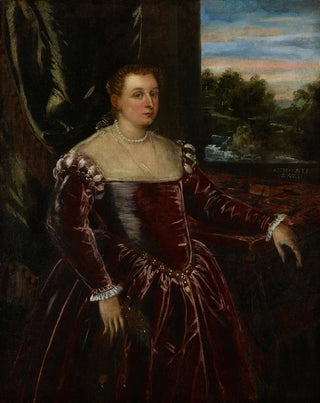Art print | Portrait of Dogaressa Morosina Morosini - Jacopo Tintoretto's workshop


View from behind

Frame (optional)
The "Portrait of Dogaressa Morosina Morosini," attributed to Jacopo Tintoretto's workshop, is a work that goes beyond merely capturing a moment in time. It evokes a rich history, that of a noble woman from Venice, whose gaze and demeanor reflect both power and grace. This painting, distinguished by its composition and use of light, transports the viewer into the opulent world of the Italian Renaissance. Through this art print, the artist manages to capture the very essence of dignity and refinement, characteristic of the female figures of that era.
Style and uniqueness of the work
Tintoretto's style is often marked by a particular dynamism, a way of playing with light and shadow that gives striking depth to his portraits. In the case of Morosina Morosini, the chosen color palette, ranging from rich tones to delicate nuances, emphasizes the sumptuous nature of the Dogaressa's gown, while the dark background highlights her silhouette. Morosina's slightly tilted posture, combined with her expression that is both gentle and determined, creates a narrative tension that invites the viewer to wonder about her story. Every detail, from the sparkling jewelry to the delicate folds of the clothing, testifies to the technical skill of the painter and his workshop, while revealing a rare artistic sensitivity.
The artist and his influence
Jacopo Tintoretto, an emblematic figure of Venetian painting, distinguished himself through his bold and innovative approach. Influenced by the great masters of his time, he nonetheless developed a style that is uniquely his own, characterized by intense expressiveness and mastery of perspective. His work had a significant impact on Baroque painting, inspiring many artists to explore similar themes of dramatization and movement. The depiction of Morosina Morosini in this portrait exemplifies his talent for immortalizing historical figures while endowing them with a human dimension. Through his works, Tintoretto sought to transcend mere representation to capture the soul of his subjects, a goal that is reflected in

Matte finish

View from behind

Frame (optional)
The "Portrait of Dogaressa Morosina Morosini," attributed to Jacopo Tintoretto's workshop, is a work that goes beyond merely capturing a moment in time. It evokes a rich history, that of a noble woman from Venice, whose gaze and demeanor reflect both power and grace. This painting, distinguished by its composition and use of light, transports the viewer into the opulent world of the Italian Renaissance. Through this art print, the artist manages to capture the very essence of dignity and refinement, characteristic of the female figures of that era.
Style and uniqueness of the work
Tintoretto's style is often marked by a particular dynamism, a way of playing with light and shadow that gives striking depth to his portraits. In the case of Morosina Morosini, the chosen color palette, ranging from rich tones to delicate nuances, emphasizes the sumptuous nature of the Dogaressa's gown, while the dark background highlights her silhouette. Morosina's slightly tilted posture, combined with her expression that is both gentle and determined, creates a narrative tension that invites the viewer to wonder about her story. Every detail, from the sparkling jewelry to the delicate folds of the clothing, testifies to the technical skill of the painter and his workshop, while revealing a rare artistic sensitivity.
The artist and his influence
Jacopo Tintoretto, an emblematic figure of Venetian painting, distinguished himself through his bold and innovative approach. Influenced by the great masters of his time, he nonetheless developed a style that is uniquely his own, characterized by intense expressiveness and mastery of perspective. His work had a significant impact on Baroque painting, inspiring many artists to explore similar themes of dramatization and movement. The depiction of Morosina Morosini in this portrait exemplifies his talent for immortalizing historical figures while endowing them with a human dimension. Through his works, Tintoretto sought to transcend mere representation to capture the soul of his subjects, a goal that is reflected in






